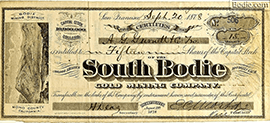July 4, 1961 – Bodie is dedicated as a National Historic Landmark.
National Historic Landmarks (NHLs) are nationally significant historic places designated by the Secretary of the Interior because they possess exceptional value or quality in illustrating or interpreting the heritage of the United States. Bodie was designated a National Historic Landmark on July 4, 1961 for its significance as the finest example of a mining “ghost town” in the West.
Bodie, once a bustling community of gold miners, with salons, hotels, shops, churches, and public buildings, experienced the rhythms of boom and bust that are common in mining communities from 1859 to 1942. During the peaks of gold mining, Bodie had up to fifty mining companies operating simultaneously with thousands of miners and thousands more people providing services such as meals, laundry, brewing, and metal work to the miners, their families and the companies they worked for. During the 1880 federal census 5,275 individuals were listed as residences of #Bodie. They represented 43 states and territories, and 31 different countries from Arabia and Australia to Russia and Wales. Italian, Irish, English, Polish, Mexican, Swiss, and Chinese immigrants mixed with Paiute Native Americans and people born in every state in the nation. By the 1940 census, only 122 people claimed to live in Bodie. However, the diversity of the population remained and represented 24 states and six different countries. Today, the park is visited by an annual average of 200,000 people from around the world.
